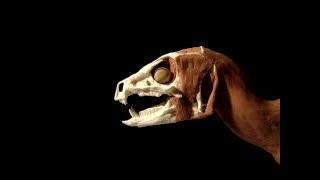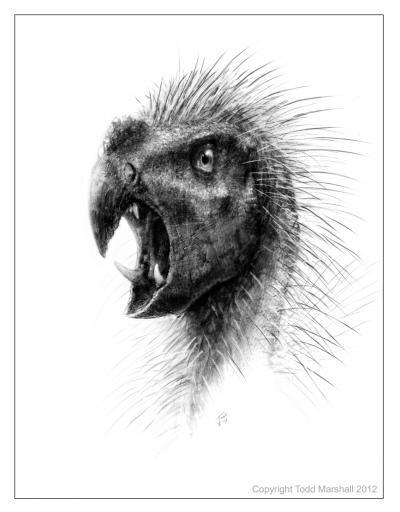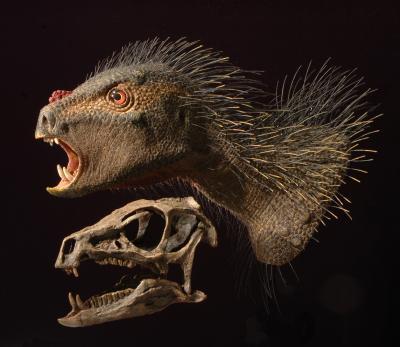Self-defense and competitive sparring for mates is more likely their role, argues Sereno in the study, based on microscopic examination of the teeth of Pegomastax and kin. Wear facets and chipped enamel suggest that the fangs of Pegomastax and other heterodontosaurs were used like those of living fanged deer for nipping or even digging rather than slicing flesh.
A bizarre covering of bristles, something like that of a porcupine, likely covered most of the body of Pegomastax, which measured less than two-feet in length and weighed less than a housecat. These bristles first came to light in a similar-sized heterodontosaur, Tianyulong, discovered recently in China and described in the study. Buried in lake sediment and covered by volcanic ash, Tianyulong preserves hundreds of bristles spread across its body from its neck to the tip of its tail. In life, dwarf-sized heterodontosaurs like Pegomastax would have scampered around in search of suitable plants, says Sereno, looking something like a "nimble two-legged porcupine".

This shows the making of the Heterodontosaurus flesh model. Muscles, skin, scales and quills are added to a skull cast of Heterodontosaurus.
(Photo Credit: Video and sculpting by Tyler Keillor)
When Pegomastax lived some 200 million years ago, the supercontinent Pangaea had just begun to split into northern and southern landmasses. Heterodontosaurs appear to have divided similarly, the study argues, the northern species with simple triangular teeth like Tianyulong and the southern species with taller crowns like Pegomastax.
Sereno marvels at these punk-sized early herbivores that spread across the globe. Although virtually unknown to the public, "Pegomastax and kin were the most advanced plant-eaters of their day".

This shows the new dinosaur dwarf Pegomastax from South Africa. With jaws only 1-inch in length, plant-eating Pegomastax ("thick jaw") is one of the smallest dinosaurs ever discovered.
(Photo Credit: Drawing by Todd Marshall)

This is a Heterodontosaurus flesh model and skull. Skin, scales and quills are added to a cast of the skull of Heterodontosaurus, the best known heterodontosaurid from South Africa.
(Photo Credit: Photo and sculpting by Tyler Keillor.)
Source: Pensoft Publishers